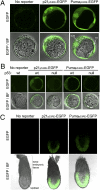Using targeted transgenic reporter mice to study promoter-specific p53 transcriptional activity
- PMID: 22307631
- PMCID: PMC3277193
- DOI: 10.1073/pnas.1114173109
Using targeted transgenic reporter mice to study promoter-specific p53 transcriptional activity
Abstract
The p53 transcription factor modulates gene expression programs that induce cell cycle arrest, senescence, or apoptosis, thereby preventing tumorigenesis. However, the mechanisms by which these fates are selected are unclear. Our objective is to understand p53 target gene selection and, thus, enable its optimal manipulation for cancer therapy. We have generated targeted transgenic reporter mice in which EGFP expression is driven by p53 transcriptional activity at a response element from either the p21 or Puma promoter, which induces cell cycle arrest/senescence and apoptosis, respectively. We demonstrate that we could monitor p53 activity in vitro and in vivo and detect variations in p53 activity depending on the response element, tissue type, and stimulus, thereby validating our reporter system and illustrating its utility for preclinical drug studies. Our results also show that the sequence of the p53 response element itself is sufficient to strongly influence p53 target gene selection. Finally, we use our reporter system to provide evidence for p53 transcriptional activity during early embryogenesis, showing that p53 is active as early as embryonic day 3.5 and that p53 activity becomes restricted to embryonic tissue by embryonic day 6.5. The data from this study demonstrate that these reporter mice could serve as powerful tools to answer questions related to basic biology of the p53 pathway, as well as cancer therapy and drug discovery.
Conflict of interest statement
The authors declare no conflict of interest.
Figures





Similar articles
-
Transgenic mouse model for studying the transcriptional activity of the p53 protein: age- and tissue-dependent changes in radiation-induced activation during embryogenesis.EMBO J. 1997 Mar 17;16(6):1381-90. doi: 10.1093/emboj/16.6.1381. EMBO J. 1997. PMID: 9135153 Free PMC article.
-
Combined loss of PUMA and p21 accelerates c-MYC-driven lymphoma development considerably less than loss of one allele of p53.Oncogene. 2016 Jul 21;35(29):3866-71. doi: 10.1038/onc.2015.457. Epub 2015 Dec 7. Oncogene. 2016. PMID: 26640149
-
Transcriptional repression of taurine transporter gene (TauT) by p53 in renal cells.J Biol Chem. 2002 Oct 18;277(42):39266-73. doi: 10.1074/jbc.M205939200. Epub 2002 Aug 5. J Biol Chem. 2002. PMID: 12163498
-
Tumor-specific adenovirus-mediated PUMA gene transfer using the survivin promoter enhances radiosensitivity of breast cancer cells in vitro and in vivo.Breast Cancer Res Treat. 2009 Sep;117(1):45-54. doi: 10.1007/s10549-008-0163-6. Epub 2008 Sep 13. Breast Cancer Res Treat. 2009. PMID: 18791823
-
Quantitative analysis of p53-targeted gene expression and visualization of p53 transcriptional activity following intratumoral administration of adenoviral p53 in vivo.Mol Cancer Ther. 2004 Jan;3(1):93-100. Mol Cancer Ther. 2004. PMID: 14749479
Cited by
-
Computational identification of a transiently open L1/S3 pocket for reactivation of mutant p53.Nat Commun. 2013;4:1407. doi: 10.1038/ncomms2361. Nat Commun. 2013. PMID: 23360998 Free PMC article.
-
Critical Role for P53 in Regulating the Cell Cycle of Ground State Embryonic Stem Cells.Stem Cell Reports. 2020 Feb 11;14(2):175-183. doi: 10.1016/j.stemcr.2020.01.001. Epub 2020 Jan 30. Stem Cell Reports. 2020. PMID: 32004494 Free PMC article.
-
Optimisation of TP53 reporters by systematic dissection of synthetic TP53 response elements.Nucleic Acids Res. 2023 Oct 13;51(18):9690-9702. doi: 10.1093/nar/gkad718. Nucleic Acids Res. 2023. PMID: 37650627 Free PMC article.
-
Chronic inflammation and cancer: potential chemoprevention through nuclear factor kappa B and p53 mutual antagonism.J Inflamm (Lond). 2014 Aug 9;11:23. doi: 10.1186/1476-9255-11-23. eCollection 2014. J Inflamm (Lond). 2014. PMID: 25152696 Free PMC article. Review.
-
An Updated View of the Roles of p53 in Embryonic Stem Cells.Stem Cells. 2022 Oct 21;40(10):883-891. doi: 10.1093/stmcls/sxac051. Stem Cells. 2022. PMID: 35904997 Free PMC article.
References
-
- Petitjean A, Achatz MI, Borresen-Dale AL, Hainaut P, Olivier M. TP53 mutations in human cancers: Functional selection and impact on cancer prognosis and outcomes. Oncogene. 2007;26:2157–2165. - PubMed
-
- Jackson JG, Post SM, Lozano G. Regulation of tissue- and stimulus-specific cell fate decisions by p53 in vivo. J Pathol. 2011;223:127–136. - PubMed
-
- Macleod KF, et al. p53-dependent and independent expression of p21 during cell growth, differentiation, and DNA damage. Genes Dev. 1995;9:935–944. - PubMed
-
- el-Deiry WS, et al. WAF1, a potential mediator of p53 tumor suppression. Cell. 1993;75:817–825. - PubMed
-
- Xiong Y, et al. p21 is a universal inhibitor of cyclin kinases. Nature. 1993;366:701–704. - PubMed
Publication types
MeSH terms
LinkOut - more resources
Full Text Sources
Molecular Biology Databases
Research Materials
Miscellaneous

